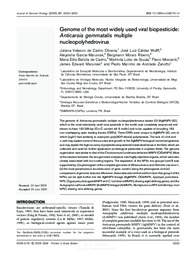Genome of the most widely used viral biopesticide: Anticarsia gemmatalis multiple nucleopolyhedrovirus.
Genome of the most widely used viral biopesticide: Anticarsia gemmatalis multiple nucleopolyhedrovirus.
Autoria: OLIVEIRA, J. V. de C.; WOLFF, J. L. C.; GARCIA-MARUNIAK, A.; RIBEIRO, B. M.; CASTRO, M. E. B. de; SOUZA, M. L. de; MOSCARDI, F.; MARUNIAK, J. E.; ZANOTTO, P. M. de A.
Resumo: The genome of Anticarsia gemmatalis multiple nucleopolyhedrovirus isolate 2D (AgMNPV-2D), which is the most extensively used virus pesticide in the world, was completely sequenced and shown to have 132 239 bp (G+C content 44.5 mol%) and to be capable of encoding 152 non-overlapping open reading frames (ORFs). Three ORFs were unique to AgMNPV-2D, one of which (ag31) had similarity to eukaryotic poly(ADP-ribose) polymerases. The lack of chiA and v-cath may explain some of the success and growth of the AgMNPV biological control programme, as it may explain the high recovery of polyhedra sequestered inside dead larvae in the field, which are collected and used for further application as biological pesticides in soybean fields. The genome organization was similar to that of the Choristoneura fumiferana defective MNPV (CfDefNPV). Most of the variation between the two genomes took place near highly repetitive regions, which were also closely associated with bro-coding regions. The separation of the NPVs into groups I and II was supported by: (i) a phenogram of the complete genomes of 28 baculovirus and Heliothis zea virus 1, (ii) the most parsimonious reconstruction of gene content along the phenograms and (iii) comparisons of genomic features. Moreover, these data also reinforced the notion that group I of the NPVs can be split further into the AgMNPV lineage (AgMNPV, CfDefNPV, Epiphyas postvittana NPV, Orgyia pseudotsugata MNPV and C. fumiferana MNPV), sharing eight defining genes, and the Autographa californica MNPV (AcMNPV) lineage (AcMNPV, Rachiplusia ou NPV and Bombyx mori NPV), sharing nine defining genes.
Ano de publicação: 2006
Tipo de publicação: Separatas
Unidade: Embrapa Soja
Observações
1 - Por padrão são exibidas publicações dos últimos 20 anos. Para encontrar publicações mais antigas, configure o filtro ano de publicação, colocando o ano a partir do qual você deseja encontrar publicações. O filtro está na coluna da esquerda na busca acima.
2 - Para ler algumas publicações da Embrapa (apenas as que estão em formato ePub), é necessário ter, no celular ou computador, um desses softwares gratuitos. Sistemas Android: Google Play Livros; IOS: iBooks; Windows e Linux: software Calibre.
Acesse outras publicações
Acesse a Base de Dados da Pesquisa Agropecuária (BDPA) para consultar o acervo completo das bibliotecas da Embrapa.

